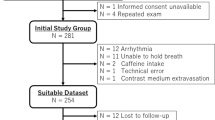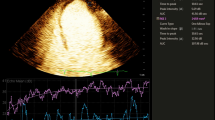Abstract
In patients with acute myocardial infarction (AMI), both myocardial blush grade (MBG) and coronary flow pattern obtained by transthoracic Doppler echocardiography (TTDE) have limitations in assessing myocardial viability. Accordingly, we assessed the usefulness of combination of MBG and TTDE in predicting myocardial damage following AMI. A total of 45 patients with anterior AMI were enrolled. Myocardial blush grade and coronary flow velocity (CFV), diastolic deceleration time (DDT), and coronary flow velocity reserve (CFVR) were measured immediately after reperfusion. The regional wall motion score index (RWMSI) was measured at 14 days after onset. The MBG was normal in 12 patients. The RWMSI was significantly better in the patients with normal than with abnormal MBG (1.65 ± 0.29 vs 2.03 ± 0.46, P < 0.05). Among the coronary flow indices, only DDT showed the significant correlation with RWMSI (P < 0.05, r = −0.44). To predict RWMSI ≥2, sensitivity and positive predictive value (PPV) were 86.3% and 65.5% in DDT alone, 90.9% and 65.5% in MBG alone, respectively. Predictable value was enhanced by the combination with DDT and MBG, with sensitivity of 100% and PPV of 70.8% in 31 patients whose results of both corresponded. MBG in conjunction with TTDE was useful in predicting myocardial damage after anterior AMI.
Similar content being viewed by others
References
Stone GW, Grines CL, Rothbaum D, Browne KF, O’Keefe J, Overlie PA, Donohue BC, Chelliah N, Vlietstra R, Catlin T, O’Neill WW (1997) Analysis of the relative costs and effectiveness of primary angioplasty versus tissue-type plasminogen activator: the Primary Angioplasty in Myocardial Infarction (PAMI) trial. The PAMI Trial Investigators. J Am Coll Cardiol 29:901–907
Antman EM, Anbe DT, Armstrong PW, Bates ER, Green LA, Hand M, Hochman JS, Krumholz HM, Kushner FG, Lamas GA, Mullany CJ, Ornato JP, Pearle DL, Sloan MA, Smith SC Jr (2004) ACC/AHA guidelines for the management of patients with STelevation myocardial infarction — executive summary. A report of the American College of Cardiology/American Heart Association Task Force on Practice Guidelines (Writing Committee to revise the 1999 guidelines for the management of patients with acute myocardial infarction). J Am Coll Cardio 144:671–719
Keeley EC, Boura JA, Grines CL (2003) Primary angioplasty versus intravenous thrombolytic therapy for acute myocardial infarction: a quantitative review of 23 randomised trials. Lancet 361:13–20
Kasanuki H, Honda T, Haze K, Sumiyoshi T, Horie T, Yagi M, Yamaguchi J, Ishii Y, Fujii SY, Nagashima M, Okada H, Koganei H, Koyanagi R, Tsurumi Y, Kimura H, Ogawa H (2005) A large-scale prospective cohort study on the current status of therapeutic modalities for acute myocardial infarction in Japan: rationale and initial results of the HIJAMI Registry. Am Heart J 150:411–418
Braunwald E, Kloner RA (1985) Myocardial reperfusion: a double-edged sword? J Clin Invest 76:1713–1719
Ito H, Tomooka T, Sakai N, Yu H, Higashino Y, Fujii K, Masuyama T, Kitabatake A, Minamino T (1992) Lack of myocardial perfusion immediately after successful thrombolysis. A predictor of poor recovery of left ventricular function in anterior myocardial infarction. Circulation 85:1699–1705
TIMI Study Group (1985) The Thrombolysis in Myocardial Infarction (TIMI) trial. Phase I findings. N Engl J Med 312:932–936
Akasaka T, Yoshida K, Kawamoto T, Kaji S, Ueda Y, Yamamuro A, Takagi T, Hozumi T (2000) Relation of phasic coronary flow velocity characteristics with TIMI perfusion grade and myocardial recovery after primary percutaneous transluminal coronary angioplasty and rescue stenting. Circulation 101:2361–2367
van’ t Hof AW, Liem A, Suryapranata H, Hoorntje JC, de Boer MJ, Zijlstra F (1998) Angiographic assessment of myocardial reperfusion in patients treated with primary angioplasty for acute myocardial infarction: myocardial blush grade. Zwolle Myocardial Infarction Study Group. Circulation 97:2302–2306
Henriques JP, Zijlstra F, van’t Hof AW, de Boer MJ, Dambrink JH, Gosselink M, Hoorntje JC, Suryapranata H (2003) Angiographic assessment of reperfusion in acute myocardial infarction by myocardial blush grade. Circulation 107:2115–2119
Ninomiya Y, Hamasaki S, Saihara K, Ishida S, Kataoka T, Ogawa M, Orihara K, Oketani N, Fukudome T, Okui H, Ichiki T, Shinsato T, Kubozono T, Mizoguchi E, Ichiki H, Tei C (2008) Comparison of effect between nitrates and calcium channel antagonist on vascular function in patients with normal or mildly diseased coronary arteries. Heart Vessels 23:83–90
Nemes A, Forster T, Geleijnse MI, Soliman OI, Ten Cate FJ, Csanady M (2008) Prognostic value of coronary flow reserve and aortic distensibility indices in patients with suspected coronary artery disease. Heart Vessels 23:167–173
Takagi A, Tsurumi Y, Ishizuka N, Omori H, Arai K, Hagiwara N, Kasanuki H (2006) Single administration of cerivastatin, an HMG-CoA reductase inhibitor, improves the coronary flow velocity reserve: a transthoracic Doppler echocardiography study. Heart Vessels 21:298–301
Rigo F, Varga Z, Di Pede F, Grassi G, Turiano G, Zuin G, Coli U, Raviele A, Picano E (2004) Early assessment of coronary flow reserve by transthoracic Doppler echocardiography predicts late remodeling in reperfused anterior myocardial infarction. J Am Soc Echocardiogr 17:750–755
Tani T, Tanabe K, Kureha F, Katayama M, Kinoshita M, Tamita K, Oda T, Ehara N, Kaji S, Yamamuro A, Morioka S, Kihara Y (2007) Transthoracic Doppler echocardiographic assessment of left anterior descending coronary artery and intramyocardial artery predicts left ventricular remodeling and wall-motion recovery after acute myocardial infarction. J Am Soc Echocardiogr 20:813–819
Saraste A, Koskenvuo JW, Saraste M, Parkka J, Toikka J, Naum A, Ukkonen H, Knuuti J, Airaksinen J, Hartiala J (2007) Coronary artery flow velocity profile measured by transthoracic Doppler echocardiography predicts myocardial viability after acute myocardial infarction. Heart 93:456–457
Killip T 3rd, Kimball JT (1967) Treatment of myocardial infarction in a coronary care unit. A two year experience with 250 patients. Am J Cardiol 20:457–464
Forrester JS, Diamond G, Chatterjee K, Swan HJ (1976) Medical therapy of acute myocardial infarction by application of hemodynamic subsets (first of two parts). N Engl J Med 295:1356–1362
Kawamoto T, Yoshida K, Akasaka T, Hozumi T, Takagi T, Kaji S, Ueda Y (1999) Can coronary blood flow velocity pattern after primary percutaneous transluminal coronary angioplasty predict recovery of regional left ventricular function in patients with acute myocardial infarction? Circulation 100:339–345
Schiller NB, Shah PM, Crawford M, DeMaria A, Devereux R, Feigenbaum H, Gutgesell H, Reichek N, Sahn D, Schnittger I (1989) Recommendations for quantitation of the left ventricle by two-dimensional echocardiography. American Society of Echocardiography Committee on Standards, Subcommittee on Quantitation of Two-Dimensional Echocardiograms. J Am Soc Echocardiogr 2:358–367
Hoffmann R, Haager P, Lepper W, Franke A, Hanrath P (2003) Relation of coronary flow pattern to myocardial blush grade in patients with first acute myocardial infarction. Heart 89:1147–1151
Yamamoto K, Ito H, Iwakura K, Kawano S, Ikushima M, Masuyama T, Ogihara T, Fujii K (2002) Two different coronary blood flow velocity patterns in thrombolysis in myocardial infarction flow grade 2 in acute myocardial infarction: insight into mechanism of microvascular dysfunction. J Am Coll Cardiol 40:1755–1760
Hirsch A Nijveldt R, Haeck JD, Beek AM, Koch KT, Henriques JP, van der Schaaf RJ, Vis MM, Baan J Jr, de Winter RJ, Tijssen JG, van Rossum AC, Piek JJ (2008) Relation between the assessment of microvascular injury by cardiovascular magnetic resonance and coronary Doppler flow velocity measurements in patients with acute anterior wall myocardial infarction. J Am Coll Cardiol 51:2239–2240
Author information
Authors and Affiliations
Corresponding author
Rights and permissions
About this article
Cite this article
Goto, K., Takagi, A., Arai, K. et al. Noninvasive assessment of myocardial damage after acute anterior myocardial infarction: myocardial blush grade in conjunction with analysis of coronary flow pattern. Heart Vessels 25, 299–305 (2010). https://doi.org/10.1007/s00380-009-1209-3
Received:
Accepted:
Published:
Issue Date:
DOI: https://doi.org/10.1007/s00380-009-1209-3




